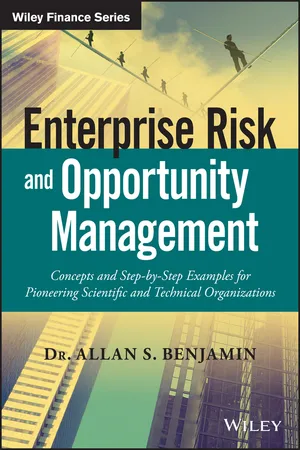
Enterprise Risk and Opportunity Management
Concepts and Step-by-Step Examples for Pioneering Scientific and Technical Organizations
Allan S. Benjamin
- English
- ePUB (mobile friendly)
- Available on iOS & Android
Enterprise Risk and Opportunity Management
Concepts and Step-by-Step Examples for Pioneering Scientific and Technical Organizations
Allan S. Benjamin
About This Book
Risk management strategy for the pioneering technological sector
Enterprise Risk and Opportunity Management provides much-needed guidance tailored specifically to the technological sector. While most enterprise risk management guides are written for traditional businesses and finance firms, this book translates effective enterprise risk and opportunity management (EROM) principles into strategies and practices that work for government, nonprofit, and for-profit organizations in the technological space. Originally designed for noncommercial pioneering enterprises like NASA, an entire chapter is now devoted toward applying the methods to profit-making technological enterprises.
A 40-year veteran of the tech sector, Dr. Allan Benjamin outlines risk management strategies for organizations in which the advancement and integration of science and technology within complex systems is necessary for accomplishment of the mission. Commercial EROM strategies do not translate directly when the development and implementation of risky technologies is the organization's primary objective, and clumsy or near-sighted implementation can easily cripple progress. This book provides authoritative guidance tailored to the sector's specialized needs.
- Maximize opportunity while effectively managing risk
- Understand the core principles of the technological EROM approach and its interfaces with the management of the organization
- Comprehend the intricacies of aggregating risks and opportunities from lower to higher levels of the organization
- Gain expert insights specific to the technology sector
- Mitigate and control the risk that comes with pursuing discovery
In practice, EROM in this sector involves working with mostly qualitative data, and is characterized by high uncertainty. Managing risk without handicapping the organization requires a specific set of adjustments to traditional EROM, and a more nuanced approach to the idea of "acceptable risk. Balance is key in technological EROM, and Enterprise Risk and Opportunity Management provides foundational guidance, real-world strategy, and enlightening examples for getting it right.
Frequently asked questions
Information
Chapter 1
An EROM Primer for Organizations Concerned with Technical Research, Integration, and Operations (TRIO Enterprises)
1.1 EROM Scope and Objectives for TRIO Enterprises
1.1.1 What Is EROM?
- “Aligning risk appetite and strategy—Management considers the entity's risk appetite in evaluating strategic alternatives, setting related objectives, and developing mechanisms to manage related risks.1
- “Enhancing risk response decisions—Enterprise risk management provides the rigor to identify and select among alternative risk responses—risk avoidance, reduction, sharing, and acceptance.
- “Reducing operational surprises and losses—Entities gain enhanced capability to identify potential events and establish responses, reducing surprises and associated costs or losses.
- “Identifying and managing multiple and cross-enterprise risks—Every enterprise faces a myriad of risks affecting different parts of the organization, and enterprise risk management facilitates effective response to the interrelated impacts, and integrated responses to multiple risks.
- “Seizing opportunities—By considering a full range of potential events, management is positioned to identify and proactively realize opportunities.
- “Improving deployment of capital—Obtaining robust risk information allows management to effectively assess overall capital needs and enhance capital allocation.”
1.1.2 Why Is EROM Important to TRIO Enterprises?
1.1.3 What Kinds of Risk and Opportunity Are Considered within EROM for TRIO Enterprises?
- Strategic risk refers to shortfalls in the ability of an organization to adequately achieve the long-term goals of its stated mission. In part, strategic risk may be equated with the potential for an organization to fail in accomplishing one or more of its strategic objectives. Inferentially, it additionally includes the potential for an organization to fail to formulate its strategic objectives in a manner that best serves its overall mission.
- Performance risk refers to shortfalls in the ability of an organization to achieve its shorter-term performance plan. Performance risk in part concerns the potential for an organization to fail to accomplish one or more of the performance objectives in its performance plan. It additionally includes the potential for an organization to fail to formulate its performance objectives in a manner that best serves its strategic objectives.
- Program/project risk is the potential for performance shortfalls, which may be realized in the future, with respect to achieving explicitly established and stated program/project performance requirements. Performance shortfalls for programs/projects may be related to any or all of the following mission execution domains: safety, technical, cost, and schedule.
- Institutional risk concerns risks to infrastructure, information technology, resources, personnel, assets, processes, occupational safety, environmental management, or security. They affect capabilities and resources necessary for mission success, including institutional flexibility to respond to changing mission needs and compliance with external requirements such as government regulations.
- Requirement risk is the risk of not satisfying the requirements of the organization's stakeholders and regulators. Requirements to be satisfied may include environmental safety and health (ES&H) protection, protection against fraud and misconduct, equal opportunity and other labor requirements, and in the case of federal agencies, federal mandates directed at achieving specific goals in the areas of public education, international cooperation, and commercial partnerships.
- Reputational risk concerns risks that could jeopardize the viability of the organization, and includes risks to financial health, legal risks, and public confidence risks. The latter category includes the risk of a catastrophic accident or other high-profile loss attributable to mismanagement or malfeasance.